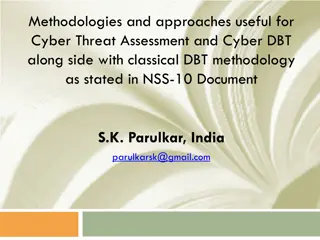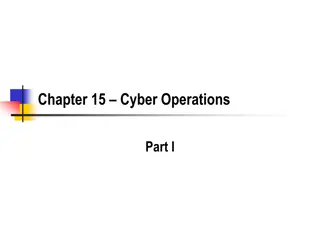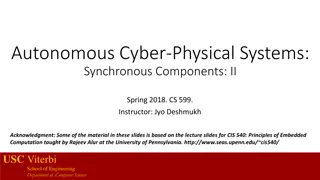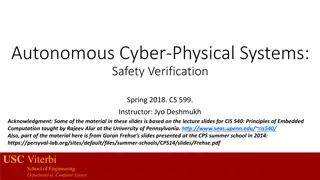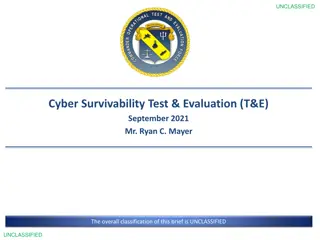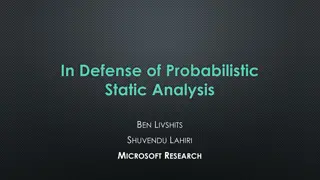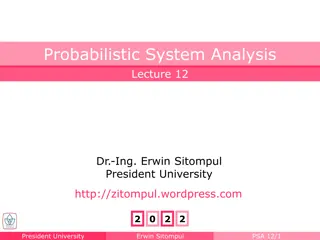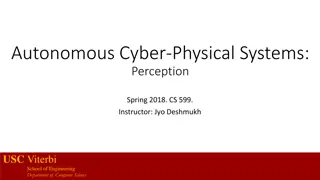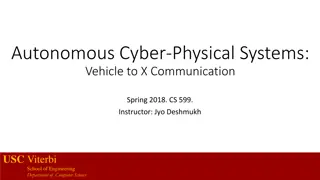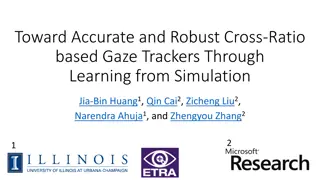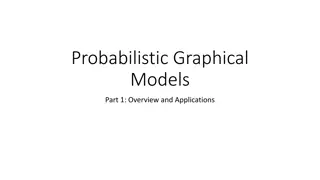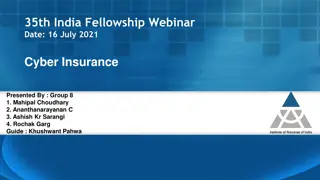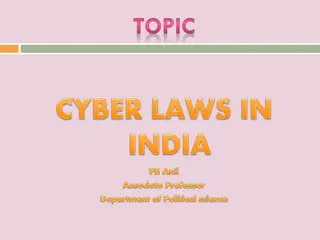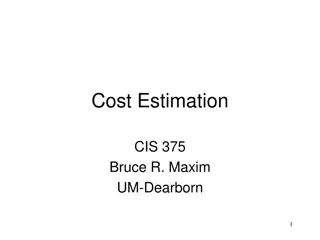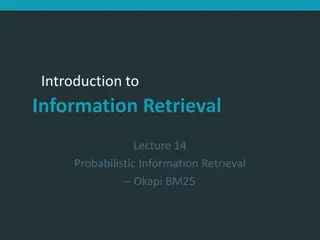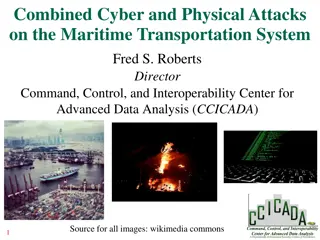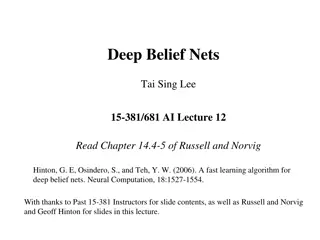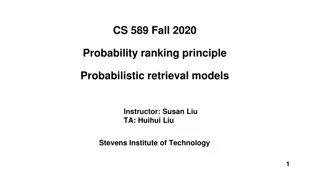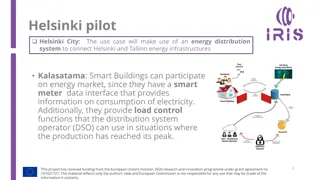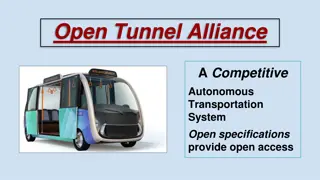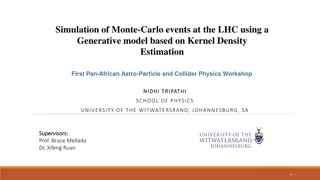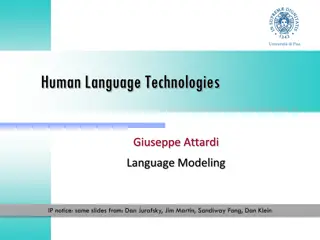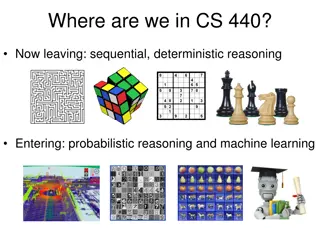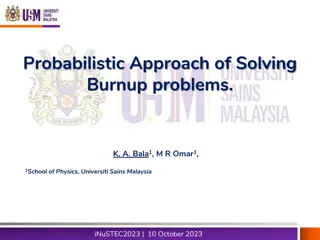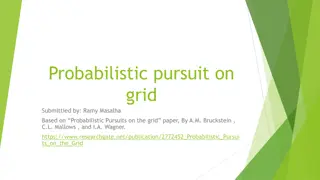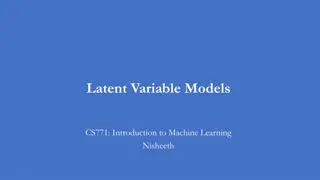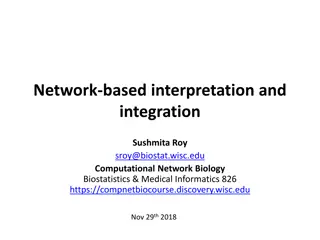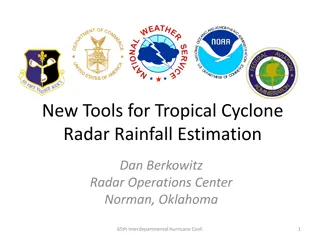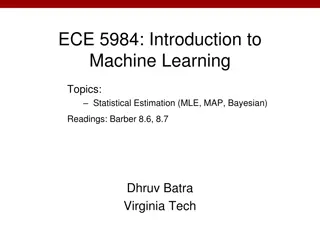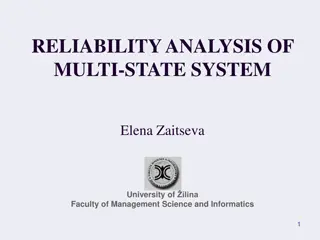State Estimation and Probabilistic Models in Autonomous Cyber-Physical Systems
Understanding state estimation in autonomous systems is crucial for determining internal states of a plant using sensors. This involves dealing with noisy measurements, employing algorithms like Kalman Filter, and refreshing knowledge on random variables and statistics. The course covers topics such as Kalman Filter, Markov Chains, Hidden Markov Models, and more to enhance comprehension in this field of study.
Download Presentation

Please find below an Image/Link to download the presentation.
The content on the website is provided AS IS for your information and personal use only. It may not be sold, licensed, or shared on other websites without obtaining consent from the author. Download presentation by click this link. If you encounter any issues during the download, it is possible that the publisher has removed the file from their server.
E N D
Presentation Transcript
Autonomous Cyber-Physical Systems: State Estimation and Probabilistic Models Spring 2018. CS 599. Instructor: Jyo Deshmukh This lecture also some sources other than the textbooks, full bibliography is included at the end of the slides. USC Viterbi School of Engineering Department of Computer Science
Layout Kalman Filter Probabilistic Models Markov Chains Hidden Markov Models Markov Decision Processes USC Viterbi School of Engineering Department of Computer Science 2
What is state estimation and why is it needed? ? ? Plant Given a black box component, we can try to use a linear or nonlinear system to model it (maybe based on physics, or data-driven) Model may posit that the plant has ? internal states, but we typically have access only to the outputs of the model (whatever we can measure using a sensor) May need internal states to implement controller: how do we estimate them? State estimation: Problem of determining internal states of the plant USC Viterbi School of Engineering Department of Computer Science 3
Deterministic vs. Noisy case Typically sensor measurements are noisy (manufacturing imperfections, environment uncertainty, errors introduced in signal processing, etc.) In the absence of noise, the model is deterministic: for the same input you always get the same output Can use a simpler form of state estimator called an observer (e.g. a Luenberger observer) In the presence of noise, we use a state estimator, such as a Kalman Filter Kalman Filter is one of the most fundamental algorithm that you will see in autonomous systems, robotics, computer graphics, USC Viterbi School of Engineering Department of Computer Science 4
Random variables and statistics refresher For random variable ?, ? ? : expected value of ?, also known as mean Suppose ?[?] = ? : then var(w) : variance of ?, is ? ? ?2 For random variables ? and ?, cov ?,? : covariance of ? and ? cov ?,? = ? (? ?(?)(? ? ? For random vector?, ? ? is a vector For random vectors, ? ?and ? ? , cross-covariance matrix is ? ? matrix: cov ?,? = ? ? ? ? ? ? ? ? ? ?,?2 : ? is a normally distributed variable with mean ? and variance ? T USC Viterbi School of Engineering Department of Computer Science 5
Data fusion example Using radar and a camera to estimate the distance to the lead car: Measurement is never free of noise Actual distance: ? Measurement with radar: ?1= ? + ?1 (?1 ? ?1,?1 With camera: ?2= ? + ?2 (?2 ?(?2,?2 How do you combine the two estimates? 2= 1 ?1= 1,?1 2= 0.5 ?2= 2,?2 2= 0.33 2 is radar noise) ? = 1.67,?2 2)is camera noise) Use a weighted average of the two estimates, prioritize more likely measurement (?1?1 (?2?2 (1 ?1 (1 ?2 ? = ?, ?2= ?1 Observe: uncertainty reduced, and mean is closer to measurement with lower uncertainty 2) + 2)+ 2) 2) 2 2 ?2 2+?2 ? = = ??1+ 1 ? ?2, where ? = 2 ?1 2?2 ?1 2+?2 2 ?1 ? ?2 USC Viterbi School of Engineering Department of Computer Science 6
Multi-variate sensor fusion Instead of estimating one quantity, we want to estimate ? quantities, then: Actual value is some vector ? Measurement noise for ?th sensor is ?? ? ??, ?, where ??is the mean vector, and ? is the covariance matrix = 1 is the information matrix For the two-sensor case: ? = 1+ 2 1( 1?1+ 2?2), and = 1+ 2 1 USC Viterbi School of Engineering Department of Computer Science 7
Motion makes things interesting What if we have one sensor and making repeated measurements of a moving object? Measurement differences are not all because of sensor noise, some of it is because of object motion Kalman filter is a tool that can include a motion model (or in general a dynamical model) to account for changes in internal state of the system Combines idea of prediction using the system dynamics with correction using weighted average (Bayesian inference) USC Viterbi School of Engineering Department of Computer Science 8
Stochastic Difference Equation Models We assume that the plant (whose state we are trying to estimate) is a stochastic discrete dynamical process with the following dynamics: ??= ??? 1+ ???+ ?? (Process Model) ??= ???+ ?? (Measurement Model) ? ??, ?? 1 State at time ?,? 1 Number of states ? Number of inputs ?? ?? ?? ?? Input at time ? ? Number of outputs Random vector representing noise in the plant, ? ?(?,??) Random vector representing sensor noise, ? ?(?,??) Output at time ? ? ? ? matrix ? ? ? matrix ? ? ? matrix USC Viterbi School of Engineering Department of Computer Science 9
Step I: Prediction We assume an estimate of ?at time ? 1, fusing information obtained by measurements till time ? 1: this is denoted ?? 1|? 1 We also assume that the error between the estimate ?? 1|? 1 and the actual ?? 1 has 0 mean, and covariance ?? 1|? 1 Now, we use these values and the state dynamics to predict the value of ?? Because we are still using measurements only up to time ? 1, we can denote this predicted value as ??|? 1, and compute it as follows: ??|? 1 ? ?? 1|? 1+ ??? USC Viterbi School of Engineering Department of Computer Science 10
Step I: Prediction continued We also need to update the predicted covariance between the predicted value and the actual value of ?? ??|? 1= cov ?? ??|? 1= cov ??? 1+ ?? ? ?? 1|? 1 = ?cov ?? 1 ??|? 1??+ ???(??) = ??? 1|? 1??+ ?? Thus, the a priori estimated state and error covariance are: ??|? 1 ? ?? 1|? 1+ ??? ??|? 1 ??? 1|? 1??+ ?? USC Viterbi School of Engineering Department of Computer Science 11
Step II: Correction This is where we basically do data fusion between new measurement and old prediction to obtain new estimate Note that data fusion is not straightforward like before because we don t really observe/measure ?? directly, but we get measurement ??, for an observable output! Idea remains similar: Do a weighted average of the prediction ??|? 1 and new information We integrate new information by using the difference between the predicted output and the observation USC Viterbi School of Engineering Department of Computer Science 12
Step II: Correction continued Predicted output: ?? ??|? 1, and error in predicted output = ?? ?? ??|? 1 We denote this expression as the innovation ?? ?? ?? ??|? 1 ? Covariance of innovation (??) can be shown to be ??+ ????|? 1?? Then to do data fusion, we use a matrix known as (optimal) Kalman gain ?? ??|? ??|? 1+ ???? ??? Finally, the updated error covariance estimate is given by: ??|? ??|? 1? ???? 1 Where, ?? is given by ??|? 1?? USC Viterbi School of Engineering Department of Computer Science 13
Correction step summary ?? ?? ?? ??|? 1 ?? ??+ ????|? 1?? ?? ??|? 1?? ??|? ??|? 1+ ???? ??|? ??|? 1? ???? Innovation ? Innovation Covariance ??? 1 Optimal Kalman Gain A posteriori state estimate A posteriori error covariance estimate USC Viterbi School of Engineering Department of Computer Science 14
What are all these equations? How to make sense? Let s take a simple one-dimensional example, with perfect observability (i.e. ? = ?).So, at each step, ??is the measurement. Then, Kalman filter prediction equations become: ??|? 1 ? ?? 1|? 1+ ?? ; ??|? 1 2 2 ?2?? 1|? 1 ??2 + uncertainty in process prior uncertainty in estimate Also, the correction equations become: Innovation: ?? ?? ??|? 1, Innovation variance = ??2+ ??|? 1 Optimal gain: ? = 1 (??2+ ??|? 1 Updated state estimate: ??|? ??|? 1+ ?(?? ??|? 1) I.e. updated state estimate: ??|? 1 ? ??|? 1+ ??? (Weighted average!) 2 2 ), USC Viterbi School of Engineering Department of Computer Science 15
Extended Kalman Filter We skipped derivations of equations of the Kalman filter, but a fundamental property assumed is that the process model and measurement model are both linear. Under linear models and Gaussian process/measurement noise, a Kalman filter is an optimal state estimator (minimizes mean square error between estimate and actual state) In an EKF, state transitions and observations need not be linear functions of the state, but can be any differentiable functions I.e., the process and measurement models are as follows: ??= ? ?? 1,?? + ?? ??= ?? + ?? USC Viterbi School of Engineering Department of Computer Science 16
EKF updates Functions ? and can be used directly to compute state-prediction, and predicted measurement, but cannot be directly used to update covariances So, we instead use the Jacobian of the dynamics at the predicted state This linearizes the non-linear dynamics around the current estimate Prediction updates: ??|? 1 ?( ?? 1|? 1,??) ??|? 1 ???? 1|? 1?? ?? ???= ??|? 1,?=?? ?? ?+ ?? USC Viterbi School of Engineering Department of Computer Science 17
EKF updates continued ? ???= ??|? 1 ?? Correction updates ?? ?? ( ??|? 1) ?? ??+ ????|? 1?? ?? ??|? 1?? ??|? ??|? 1+ ???? ??|? ??|? 1? ???? Innovation ? Innovation Covariance ??? 1 Near-Optimal Kalman Gain A posteriori state estimate A posteriori error covariance estimate USC Viterbi School of Engineering Department of Computer Science 18
EKF drawbacks EKF is not in general an optimal estimator If initial state estimate is wrong filter may diverge quickly : estimates will no longer agree with reality/observations Estimated covariance matrix tends to underestimate true covariance Yet, EKF remains widely used! GPS, most navigation systems, Openpilot (for drones), Pixhawk (mobile robots), etc. EKF in practice requires lot of expert tuning of parameters Most parameters occur in process models, covariance matrices, gains etc. EKF improvement: Unscented Kalman Filter USC Viterbi School of Engineering Department of Computer Science 19
Probabilistic Models Models for components that we studied so far were either deterministic or nondeterministic. The goal of such models is to represent computation or time-evolution of a physical phenomenon. These models do not do a great job of capturing uncertainty. We can usually model uncertainty using probabilities, so probabilistic models allow us to account for likelihood of environment behaviors Machine learning/AI algorithms also require probabilistic modelling! USC Viterbi School of Engineering Department of Computer Science 20
Markov chains Markov property: A process satisfies the Markov property if it can make predictions of the future based only on its current state (i.e. future and past states of the process are independent) Time-homogeneous MC : each step in the process takes the same time Discrete-Time Markov chain (DTMC), described as a tuple (?,?,?,??,?): ? is a finite set of states ?:? ? [0,1] is a transition probability function ?: ? [0,1] is the initial distribution such that ? ?? ? = 1 ?? is a set of Boolean propositions, and ?:? 2?? is a function that assigns some subset of Boolean propositions to each state USC Viterbi School of Engineering Department of Computer Science 21
Example of a Markov chain 0 0 0.3 ?,? 0.1 0.4 ?, ? Constant Speed Accelerate 0.2 ?: Checking cellphone ?: Feeling sleepy 0.5 0 0.5 0.8 0.05 0.4 ?,? Idling Brake 0.5 0.05 ?,? 1 0.2 USC Viterbi School of Engineering Department of Computer Science 22
Markov Chain Analysis Can represent transition probabilities in a matrix ?, where ? ?,? = ?( ?,? ) ? ={ accelerate, idle, brake, constant speed} 0.3 0 0.5 0.8 0.2 0 0.4 0.1 0 0.5 Chapman-Kolmogorov Equations: Let ??(?,? ) denote probability of going from state ? to ? in ? steps, then, ??+??,? = ???,? ??? ,? Corollary: ??q,q = ??(?,? ) 0.2 0 0.05 0.4 ? = 0.5 0.05 USC Viterbi School of Engineering Department of Computer Science 23
Hidden Markov Models Full system state is never observable, so HMMs only make observations or outputs available HMM is a tuple: ?,?,?,?,?,??,? ?,?,?,??,? as before ?: set of observations ?: Conditional probability of observing ? when in state ? ? USC Viterbi School of Engineering Department of Computer Science 24
Robot trying to reach moving target example What is the expected time before robot reaches target? What s the probability that robot reaches target within the next 2 steps? What s the probability that the robot hits a wall before getting to the target 3 G 2 1 R 1 2 3 4 5 6 7 Rules of the Game Each timestep the target and robot move randomly to an adjacent cell or stay in the same cell (with some probability, possibly different for each cell) When the robot and target occupy the same cell, robot declares victory USC Viterbi School of Engineering Department of Computer Science 25
Robot trying to reach moving target example If robot knows the cell in which the target is (fully observable), then this is simply a Markov chain 3 G 2 Each state is a pair (?,?), where ? is the cell occupied by R, and ? is the cell occupied by G 1 R Movement of robot and target is independent, so P ?,? , ? ,? = ???,? ??(?,? ) Compute new transition probability matrix For any initial configuration, you can find answers by using the Chapman-Kolmogorov equations 1 2 3 4 5 6 7 ?2 = ?2 ? = (1,1),? = (3,3) , ? = (2,2),? = (2,2) 1,1 ,(3,3) , 2,2 ,(2,2) USC Viterbi School of Engineering Department of Computer Science 26
What if robot cannot see all the state? Robot with noisy proximity sensors: W W W W W W R R G G G Observed noisy state True state Target state is hidden : if it is not proximal, robot does not know where the target is, and if it is proximal, robot only has noisy estimates We can assume robot knows how the target moves (left, right, top, down), and the uncertainty (as captured by the transition probability matrix): this is like the process model in KF The robot s sensors are noisy, this is like the measurement model in KF Question: Given a series of (noisy) observations, can the robot estimate where the target is? Problem very similar to KF! In fact, HMM can be viewed as a discrete-variable version of KF USC Viterbi School of Engineering Department of Computer Science 27
Interesting Problems for HMMs [Decoding] Given a sequence of observations, can you estimate the hidden state sequence? [Solution with the Viterbi Algorithm] [Likelihood] Given an HMM and an observation sequence, what is the likelihood of that observation sequence [Dynamic Programming based Forward Algorithm] [Learning] Given an observation sequence (or sequences), learn the HMM that maximizes the likelihood of that sequence [Baum-Welch or forward- backward algorithm] We will revisit this when we do sensing/localization USC Viterbi School of Engineering Department of Computer Science 28
Markov Decision Process Markov chain with a controller! Represented as a tuple (?,?,?,?,?,?), where: ?,? as before (can add ??,? to the definition if needed) ? is a finite set of actions ?:Q ? ? [0,1] is the transition probability function such that for all states ? ? and ? ?, ? ?? ?,?,? {0,1} ?:? ? is a reward function. ? ?,? defines the immediate reward received for transitioning from state ? to state ? ? [0,1] is a discount factor representing diminishing rewards with time USC Viterbi School of Engineering Department of Computer Science 29
Autonomous Robot controlling its actions Assume fixed target location Reward for transitions going to target cell = 1, otherwise 0 Just part of the robot MDP showing two different actions, each action leading to next states with some probability Which action to choose from each cell? How do we find an optimal policy (that maximizes rewards)? We will revisit this when we do reinforcement learning 0.9 (?,? + 1) up 0.1 (?,?) (?,?) 0.9 (?,? 1) dn 0.1 (? 1,?) USC Viterbi School of Engineering Department of Computer Science 30
Bibliography Kalman Filter presentation motivated by Georgia Tech Professor Frank Dellaert s lecture notes on Sensor Fusion as Weighted Averaging, notes available from Piazza. Lecture notes on HMMs, MDPs and Markov Chains http://research.cs.tamu.edu/prism/lectures/pr/pr_l23.pdf https://web.stanford.edu/~jurafsky/slp3/9.pdf http://www.robots.ox.ac.uk/~mobile/Theses/ondruska_thesis.pdf www.cs.cornell.edu/courses/cs4758/2012sp/materials/cs4758_hmm.pdf (Robot - Target example from here) https://people.eecs.berkeley.edu/~pabbeel/cs287-fa11/slides/mdps-intro-value-iteration.pdf (Robot-Fixed Target example from here) Wikipedia entries on Kalman Filter, MDPs and Markov chains are very good. Also used this book for its discussion on probabilistic systems: Baier, Christel, Joost-Pieter Katoen, and Kim Guldstrand Larsen. Principles of model checking. MIT press, 2008. USC Viterbi School of Engineering Department of Computer Science 31



